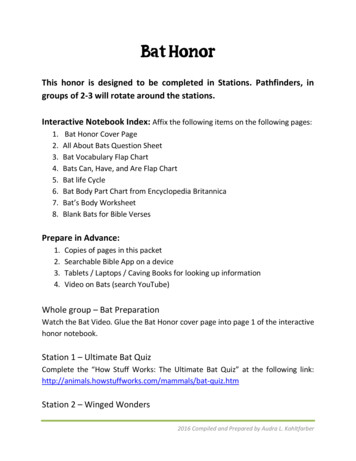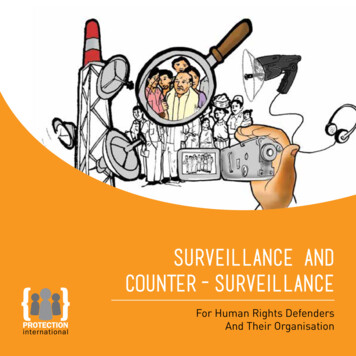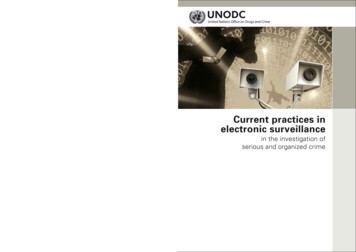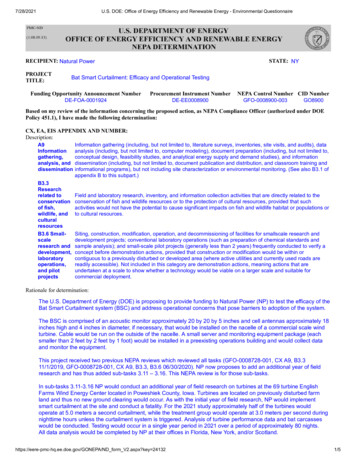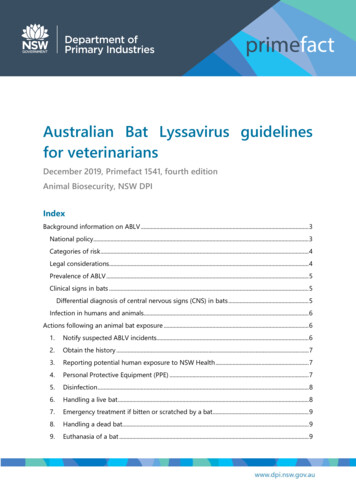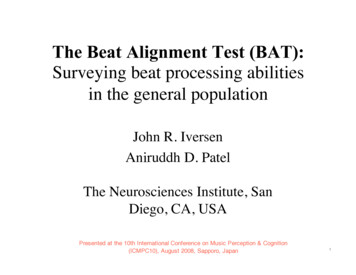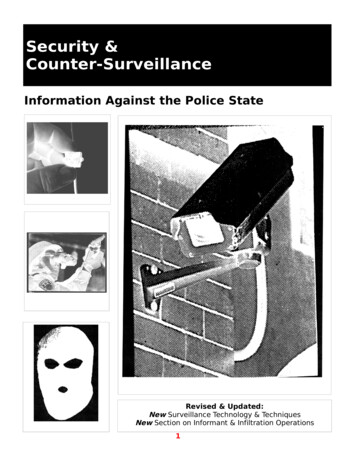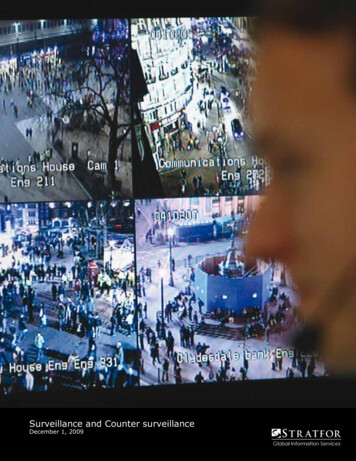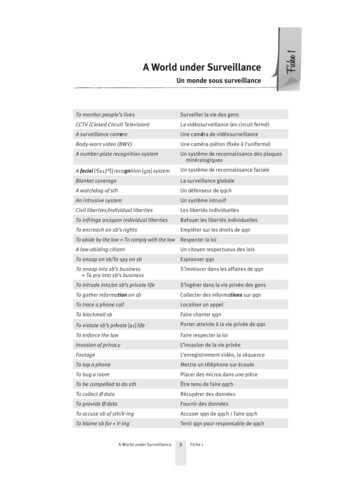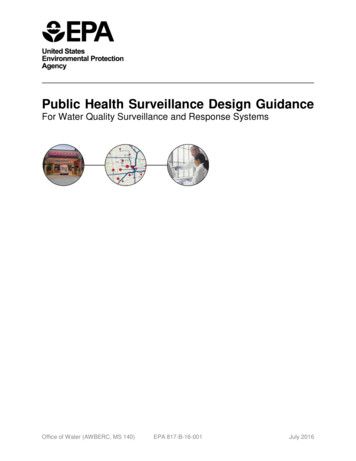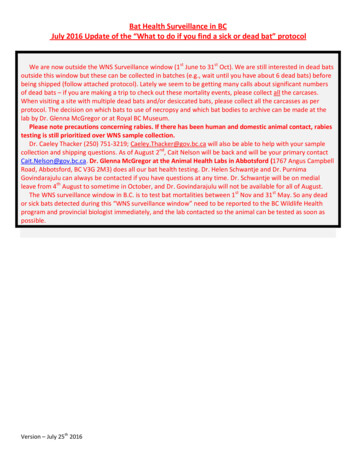
Transcription
Bat Health Surveillance in BCJuly 2016 Update of the “What to do if you find a sick or dead bat” protocolWe are now outside the WNS Surveillance window (1st June to 31st Oct). We are still interested in dead batsoutside this window but these can be collected in batches (e.g., wait until you have about 6 dead bats) beforebeing shipped (follow attached protocol). Lately we seem to be getting many calls about significant numbersof dead bats – if you are making a trip to check out these mortality events, please collect all the carcases.When visiting a site with multiple dead bats and/or desiccated bats, please collect all the carcasses as perprotocol. The decision on which bats to use of necropsy and which bat bodies to archive can be made at thelab by Dr. Glenna McGregor or at Royal BC Museum.Please note precautions concerning rabies. If there has been human and domestic animal contact, rabiestesting is still prioritized over WNS sample collection.Dr. Caeley Thacker (250) 751-3219; Caeley.Thacker@gov.bc.ca will also be able to help with your samplecollection and shipping questions. As of August 2nd, Cait Nelson will be back and will be your primary contactCait.Nelson@gov.bc.ca. Dr. Glenna McGregor at the Animal Health Labs in Abbotsford (1767 Angus CampbellRoad, Abbotsford, BC V3G 2M3) does all our bat health testing. Dr. Helen Schwantje and Dr. PurnimaGovindarajulu can always be contacted if you have questions at any time. Dr. Schwantje will be on medialleave from 4th August to sometime in October, and Dr. Govindarajulu will not be available for all of August.The WNS surveillance window in B.C. is to test bat mortalities between 1st Nov and 31st May. So any deador sick bats detected during this “WNS surveillance window” need to be reported to the BC Wildlife Healthprogram and provincial biologist immediately, and the lab contacted so the animal can be tested as soon aspossible.Version – July 25th 2016
Bat Health Surveillance in BC - 2016This document is intended for use by Community Bat Program Coordinators and wildlife biologists.What to do if you find a batBats are the only reservoir for rabies in BC so it is important to take precautions when encountering a bat. If you handlebats a rabies vaccine is strongly advised. Bats prefer to rest or roost hanging upside down and above the ground, so ifyou find a bat on the ground, you can suspect the bat is dehydrated, injured or ill. Avoid handling bats. If handling of alive bat is necessary, wear thick leather gloves that a bat cannot bite through or scoop the bat into a container withouttouching it. Cover your hands with gloves or plastic bags to handle dead bats.If there is any concern at all about the risk of rabies to humans, pets or domestic animals always advise people to seekprofessional advice from their doctors, public health authority, and/or veterinarian, who will then be responsible for riskmanagement (i.e. vaccination, submitting the bat for rabies testing etc.). Bat Program Coordinators should never assumethis responsibility due to liability concerns.Proceed through the following list for guidance when you encounter a live or dead bat and need to make a decision onsteps to take.1. Has a person been in “close contact” with a bat that was alive or recently dead (not completely desiccated)(e.g. handled with bare hands, was bitten, scratched, or had contact with an open wound on the person)? Oris the person very concerned about the health implications even if you perceive risk to be low? If there is anydoubt of what close contact is, presume YES as a precaution because rabies is considered fatal if not treated.YES .Go to 2.NO .Go to 3.2. Advise the person to immediately contact their physician and/or their local public health office (Contactinformation at the end of the document) and they will decide if post-exposure prophylaxis (i.e. rabiesvaccination) is required and if the bat should be submitted for testing for rabies. If the bat is to be submitted fortesting, the public health office will coordinate the submitting of the bat for rabies testing directly to CFIA(Please see BCCDC Rabies Guidelines May 2015 document for more details). Close contact as described aboveusually requires human rabies post-exposure treatment and may require testing the bat for rabies as soon aspossible. Go to Step 5 to complete incident report or direction on how to proceed if bat is not submitted fortesting to CFIA.3. Has a domestic animal (cat, dog, or livestock) been in contact (bitten, scratched) with bat? Or is the pet ownerconcerned about the risk of rabies even if you perceive the risk to be low?YES .Go to 4.NO .Go to 5.4. The animal owner should be advised to immediately consult with their private veterinarian. The vet isresponsible for risk assessment and may contact the Public Health Veterinarian at the BC Centre for DiseaseControl at 604-829-2110 ns/rabies) for support. They willdecide what risk management is required. Risk of rabies will be determined partly on the vaccination status ofthe animal as well as other aspects of the situation. Close contact as described above usually requiresrevaccination, and sometimes rapid testing of the bat for rabies or potential quarantine of the domestic animal.If the bat is to be submitted for rabies testing, the private veterinarian will submit the bat directly to CFIA(Please see BCCDC Rabies Guidelines for Veterinarians 2015 document for more details). Precautionary action isalmost always advised as rabies is considered fatal if not treated. Go to Step 5 to complete incident report ordirection on how to proceed if bat is not submitted for testing to CFIA.5. Proceed to 6 for what to do with a bat if it has not been submitted for testing in the steps above. If the bat hasbeen submitted for testing as above, please document the incident (date, location where found, circumstance,and species of bat if known) with date and contact person/lab where the bat was submitted for testing.Version – July 25th 2016
6. Is the bat dead?YES .NO .7. Is this bat in a building and clearly capable of flight?YES.Go to 11Go to 7Conduct a safe removal of the batfrom the in-my-houseNO .Go to 88. Is the bat visibly injured?YES .NO .Go to 10Go to 99. Is this bat found during winter, or early spring?YES .NO .Go to 11Follow instructions below Avoid touching the bat, and use gloves even if you have rabies pre-exposure vaccination. If you must touchthe bat, use thick leather gloves.Observe for injuries and go to step 10 if injuries are found. If no injuries are found, then pick up or scoopwith a small trowel and place bat in the shade, on a tree trunk or wall, out of sight and where it won’t beaccessed by people, pets or predators. If possible place the bat near a shallow dish of open water, becausein the summer months bats may just be dehydrated. A small partially closed box on its side placed on a treeor wall, with a small dish of water could provide shade and drinking opportunity, and the bat can easily leavewhen it is ready to fly. Bats have trouble climbing cardboard, so tipping the box on its side allows it to leavethe box without having to climb.Place the bat at least 6 feet off of the ground as most bats cannot gain flight when taking off from theground.If you cannot find an appropriate box, another option is to put the bat in an open pillow case and tie acorner of the pillow case to a trunk/wall allowing it to climb up and fly away when ready. The pillow casegives the bat a place to hide and provides shade, and protects it from predators. If bat has not flown awaywithin a few hours after sundown, then proceed to 10.10. Contact the Wildlife Rehabilitation Network of BC at http://www.wrnbc.org/ or see below for their membersthat can care for the bat. The bat may require euthanasia and some veterinarians may assist. For further advicecall the BC Wildlife Veterinarian, Helen Schwantje at 250-751-3234 or the other contacts below.If the bat is euthanized, and you are able to obtain the dead bat follow instructions for storage and shippingbelow described in Step 11 below. The Wildlife Rehabilitators should have a copy of this protocol but it might beprudent to check with them again.11. Is rabies or white nose syndrome suspected?WNS is suspected if a sick or dead bat is found in the winter or early spring. The WNS Surveillence Window isbetween 1st November and 31st May. It is the only time that the disease is thought to be active and visible. Batstested in the summer almost always test negative even if they may have suffered from the disease in the winter,and signs such as holes in the wings persist. Visible signs of WNS are a white powdery substance present on thenose or wings and/or tears or holes in the wings. In many cases in early spring, no white substance is observed.The wings might look sticky and rough. See more information below.Rabies is suspected if the bat is on the ground, is acting abnormally (dopey or aggressive), and has no obviousinjuries. See more information on BCCDC website s/rabies.Version – July 25th 2016
YES .NO .If the bat is alive get the bat to a rehabfacility as soon as possible to decide ifthe bat should be euthanized or can berehabbed for release. If there is norehab facility in the vicinity, then aprivate vet may need to make thisdecision. If necessary, contact HelenSchwantje, Caeley Thacker, and/orPurnima Govindarajulu to providefurther guidance on a case by casebasis.In the WNS season (Nov 1st to May31st) contact the BC Wildlife HealthProgram and Dr. McGregor and shipimmediately. Outside the “WNSseason” (June 1st to Oct 31st) followinstructions for storage and/orshipping below.Storage and shipping may be a challenge for the general public. So Community Bat Coordinators and rehabilitators areurged to collect and consolidate samples for shipping to the BC Wildlife Health Biologist. Always handle dead bats with gloves (disposable vinyl or nitrile gloves are ideal) or a plastic bag over your hand.Wrap the dead bat in a couple of paper towels to provide cushioning and to retain moisture.Place the wrapped bat in a Ziploc bag and that in another Ziploc bag (double bag) as a precaution.Note from Glenna about fresh samples (but given the funding constraints this might be possible only during theWNS season): “It would be MUCH easier for me if we could get bats as fresh as possible. I’d really like to lookinto the high prevalence of pneumonia we’re seeing in the bats submitted so far and it is difficult to assess lungsmicroscopically, particularly for viral disease, if they’ve been frozen. If they can get them to the lab within 24 to48 hours of death it would be ideal if they were refrigerated but not frozen and packaged on ice to keep themcool. If it’s a weekend or we can’t get the bat within 24 hours, freezing is best”.Fill out the Animal Health Lab Wildlife Submission Form (PDF form attached or from Wildlife Health Biologist orfrom to l-and-crops/animal-health/ahcform -wildlife.pdf). Note that the Submitter in this form is HelenSchwantje but put your name and details under Finder. Include as much information as possible. If you areunsure about species identification, please indicate it in the form so that the species identification can beverified at the lab or Royal BC Museum. Include the filled out form in a Ziploc bag attached outside of the bagwith the bat making sure that the bag and form do not become separated during shipping.Contact the BC Wildlife Heath Biologist (250-751-3219) regarding the bat and to get a Wildlife HealthIdentification Number (WLH-ID) assigned to the bat. In the WNS season, if the landowner/private citizen whofound the incidental mortality is willing to package and ship the carcase (ask questions to make sure it is asample that is of interest, that the person will take the needed precautions during packaging and shipping, andthat they will be able to fill out the metadata form properly), then you can call Dr. Caeley Thacker (250) 7513219; Caeley.Thacker@gov.bc.ca (Cait Nelson, Cait.Nelson@gov.bc.ca after 2nd August, 2016) to get the courrieraccount number that will cover shipping charges. Outside the WNS season, collect and batch ship about six ormore carcasses at a time.Label each bag with the Wildlife Health ID number, date, submitter, contact and location.Version – July 25th 2016
BEtween 1st Nov to 31st May, it might be easiest to contact Dr. Glenna McGregor directly(Glenna.McGregor@gov.bc.ca, 604 556-3003, 1767 Angus Campbell Road, Abbotsford, BC V3G 2M3). Stillensure that you get a Wildlife Health ID number associated with the sample as that is the only way that theWildlife Program can track the sample, and get results back to the landowner if necessary.After the priority WMS sample collection period from 1st Nov to 31st May, it may be best to collect a batch ofspecimens (6 or more) before shipping them.Always ship the bats in a proper hard-sided cooler if possible and you must ship with commercial ice packs.Styrofoam containers are OK if thick and enclosed in a cardboard box. Styrofoam boxes and ice packs may beavailable free from pharmacies, veterinarians and some grocery stores as they have supplies shipped to them.During the priority sample collection period (November until the end of May), samples could be shipped directlyto Dr. Glenna McGregor. For shipping instructions: ogy-necropsyA FLNRO regional office may be able to help with packaging and shipping. All bats that have not been in humanor domestic animal contact can be sent to the Nanaimo Regional office c/o Helen Schwantje (250-751-3234),helen.schwantje@gov.bc.ca. Please contact Helen to ensure that the office knows that a shipment is arrivingon ice and that it needs to go into the freezer, in case Helen is away. Please note that Helen is away onmedical leave from August to mid-October. Cait Nelson, Cait.Nelson@gov.bc.ca will be your primary contactduring this time.In some cases, Helen may advise direct shipping to the Animal Health Lab (Dr. Glenna McGregor,Glenna.McGregor@gov.bc.ca, 604 556-3003)Desiccated bats may not need to be frozen but as a rule please freeze all of them. For now, please collect all batcarcasses including desiccated bats. WNS PCR can be done on desiccated carcasses and so can population geneticsstudies. We can always discard them later if we find that we have too many samples (not likely).White Nose Syndrome:If you find a dead bat and suspect White-nose Syndrome (WNS), please contact the people below for additionalinformation or access the Fact Sheet. At a minimum, please do the following:a. Photograph the scene, and the bat(s). Take an overall photo plus close ups as below if you are not ableto collect specimens (use necessary precautions while handling bats; and ensure that there is amillimeter scale in the photographs).Version – July 25th 2016
b. If you are able to collect specimens, follow instruction under Step 11 above for collection, packaging andshipping.If you find a live bat with overt signs of WNS and it is in the WNS vulnerability window (1st Nov to 31st May), and youhave current rabies vaccination, document the scene as above and you may collect the bat for euthanasia by aveterinarian or follow the Standard Operating Procedure for bat euthanasia (www.gov.bc.ca/wildlifehealth). However, ifat all possible, contact any of the people mentioned in this protocol for guidance before taking this step.Please contact one of the following people for advice, or before sending shipments:ContactsHelen SchwantjePhone: (250) 751-3234Email:Helen.Schwantje@gov.bc.ca(away August-mid October)Purnima GovindarajuluPhone: (250) 387-9755Email:Purnima.Govindarajulu@gov.bc.ca(away all of August)Caeley Thacker (Cait Nelsonafter 2nd August)Wildlife Health BiologistPhone: (250) @gov.bc.ca)Acknowledgements : This document was drafted and updated by (Cori Lausen, Purnima Govindarajulu, HelenSchwantje) and reviewed by members of the BCBAT Bat Health Sub-Committee (Adam Hering, ChelseaHimsworth, Cait Nelson, Juliet Craig, Glenna McGregor), the members of the Bat Action Team (in particularAimee Mitchell, Peter Ommundsen, Margaret Holm), Gavin Hanke of RBCM, and Melissa McLaws (BC Centerfor Disease Control).Version – July 25th 2016
CONTACT INFORMATION FOR PUBLIC HEALTH AGENCIES OF BCAgencyFraser Health AuthorityFraser Health AuthorityInterior Health AuthorityInterior Health AuthorityIsland Health AuthorityIsland Health AuthorityIsland Health AuthorityIsland Health AuthorityNorthern Health AuthorityNorthern Health AuthorityNorthern Health AuthorityNorthern Health AuthorityVancouver Coastal HealthVancouver Coastal HealthBritish Columbia Centre forDisease Control (BCCDC)BCCDCBCCDCVersion – July 25th 2016PositionCentral CommunicableDisease Intake Line Health ProtectionMedical Health Officer(MHO) on call after hoursCommunicable DiseaseUnitMHO on call after hoursSouth IslandCommunicable DiseaseHubCentral IslandCommunicable DiseaseHubNorth IslandCommunicable DiseaseHubMHO on call after hoursNortheast ManagerNorthern Interior ManagerNorthwest ManagerMHO on call after hoursCommunicable DiseaseControlMHO on call after hoursPhysician epidemiologistlead on rabiesPublic Health VeterinarianPhysician on call duringand after hoursContact604-507-5478 and -2110604-312-9220
Bat Rescue/Rehabilitation Centres in BC, 2015SPCA 1 855 622 7722; Provincial Call Centre, would re-direct call to nearest facility.FacilityCommunity BatProject RegionWild ARCVictoriaMountainaire Avian Rescue SocietyIsland Wildlife Natural Care CentreWildlife Rescue Assoc. of BCGibsons Wildlife RehabilitationCentreBC Wildlife Park WildlifeRehabilitation CentreSecond Chance Wildlife RescueSalt Spring IslandSouth Coast BatAction TeamSunshine CoastOkanagan/ThompsonAddress1020 Malloch Rd,Victoria6817 Headquarters Rd,Courtenay322 Langs Rd, Salt l.com5216 Glencarin Dr,Burnaby1211 Carmen Rd,Gibsons9077 Dallas 4.886.4989gwrc@sunshine.net1845 Kral Rd, QuesnelAcceptbats?yesyesyesProvide first aid care thentransfer to Wild Arcyesyes250.573.3242 ex. 230yes250.747.0275zachariastammy@yahoo.comyesNorth Island Wildlife Recovery Assoc.noGabriola Rescue of Wildlife SocietynoPacific Northwest Raptors LtdnoCritter Care Wildlife SocietynoElizabeth's Wildlife Centre SocietynoNorthern Lights Wildlife SocietySouth Okanagan RehabilitationCentre for OwlsFocus Wildlife CanadaPrince Rupert Wildlife RehabilitationShelterHillspring Wildlife RehabilitationCreature Comfort Wildlife CareJanet Gifford-BrownnoVersion – July 25th 2016OtherOnly handles animals foundon the island.nonoCannot get in touch withanyoneNo longer in serviceNo longer in serviceNumber not in service
testing, the public health office will coordinate the submitting of the bat for rabies testing directly to CFIA (Please see BCCDC Rabies Guidelines May 2015 document for more details). Close contact as described above usually requires human rabies post-exposure treatment and may require testing the bat for rabies as soon as possible.
